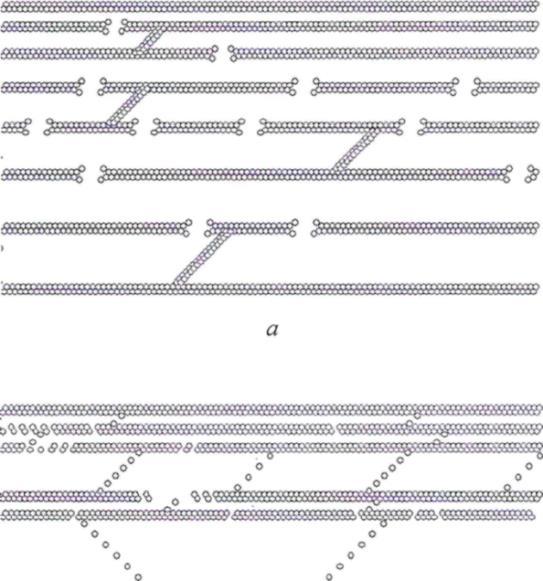
15 minute read
OF END-GRAIN WOOD TREATMENT UNDER PRESSURE
ACTA FACULTATIS XYLOLOGIAE ZVOLEN, 62(1): 29−39, 2020 Zvolen, Technická univerzita vo Zvolene DOI: 10.17423/afx.2020.62.1.03
Advertisement
Vladimir Shamaev
ABSTRACT
The process of introducing modifiers into wood from the end-grain under pressure was studied for the development of treatment technology by computer modeling. A physical model of meso-level wood treatment was developed taking into account temperature and pressure variables differing by cavities, annual layers and core rays. Analytical expressions are obtained for describing the wood impregnation process on the basis of a mathematical model. It was found that with increasing vessel diameter dV–fluid speed νl increases according to the following law: ���� =��0 +��√����,whereν0–fluid speedin the smallest vessel; β–coefficient of proportionality. Keywords: wood, vessels, treatment, computer simulation, fluid, modifier, treatment equations.
INTRODUCTION
Currently, various methods of poplar, aspen, eucalyptus, and other species wood modifying are used in order to replace hardwoods and use low-value softwood rationally (WESTINet al. 2010, GUBANOVA et al. 2013, LEKOUNOUGOU et al. 2011,WEBSITE OF ACCOYA et al. 2011). These species are used to replace valuable tree species (oak, boxwood, the mahogany, and palisander). All these methods include technological operations of impregnation, drying and pressing the wood (SHAMAEV et al. 2018, SHAMAEV et al. 2014, ROWELL et al. 2012, SHAMAEV et al. 2018) from which the operation of treatment is the least studied. All common methods of impregnation, as a rule, are based on the autoclave treatment method, when wood dried with a moisture content of not more than 30%, is treated under pressure with a modifying solution and then subjected to secondary drying to a moisture content of 612% (SANDBERG et al. 2013, SHAMAEV et al. 2018a, SHAMAEV et al. 2018b). A common disadvantage of this method is double drying of wood, which takes a lot of time (14 weeks). Diffusion impregnation of raw wood is not used, since the process lasts 26 weeks. New opportunities have been opened after the development of the end-grain wood treatment under pressure (WEBSITE OF KEBONY et al. 2018). According to this method, a raw rounded log is loaded into the installation, where an impregnating solution is fed from one end of the log under pressure of 0.83.5 MPa, and water (tree sap) flows from the other end until the entire log is completely filled (through impregnation) with the modifying solution. A pressure pulse is used to accelerate the process, and the solution is activated by ultrasound. Oily antiseptics, stabilizers of wood shapes and sizes, hardeners-nanocrystal line
cellulose, cashew nut shell liquid and antifriction lubricants (Biol, ceresin), various dyes are used as modifiers.
However, the process of end-grain wood treatment under pressure is practically not studied; all the modes are empirical ones.
Earlier attempts to model the process did not find practical application (TSHABALALA et al. 2012). Therefore, the mechanism of end-grain wood treatment under pressure taking into account technical models of hardwoods and softwoods by computer simulation is studied in this paper.
EXPERIMENTAL PART
Mathematical modeling in fluid mechanics is based on the finite element approach (ZANKEVICH et al. 1974).
With regard to modeling the process of wood impregnation, we proposed to split the entire volume of the moving fluid into a large number of balls (in the three-dimensional case) or circles (in the two-dimensional case), which are elements of the liquid that interact with each other. The diameter of the elements could be 110 microns (depending on the problem being solved), while the fluid flow was simulated quite well and, at the same time, high speed of computer calculations is provided. The spherical (or circular) shape of the elements was adopted in order to achieve isotropy of the properties of the model fluid. The basic properties of fluid (density, modulus of elasticity, thermal conductivity, etc.) were recalculated for one fluid element. The introduction of various types of balls (with appropriate properties) enabled to simultaneously consider different media in the model: various types of fluids, gases, modifiers, wood elements.
Wood and liquid are made up of circles of the same diameter to increase the versatility of the model. However, the circle elements of wood kept motionless in the process of modeling. Distributing the elements of wood in space, it is possible to achieve reproduction of both the structure of coniferous species (pines, figure 1a) and the structure of deciduous species (birch, figure 1b). The model reproduces the main structural elements of wood: tracheids, vessels, partitions, fringed and non-enlarged pores, scalariform perforation, etc.
b
Fig. 1 Representation in the models of softwoods (a) and hardwoods (b).
It suffices to take into account the minimum properties of the fluid, in particular, its mechanical properties, for estimated calculations. In this case, it is necessary to describe the Newtonian motion of a large number of bodies (fluid elements) interacting with each other by viscoelastic forces.
It was decided to use a two-dimensional model, since it significantly accelerates the calculations, which is important during the first stage.
The state of each element-circle i is determined by four variables: the Cartesian coordinates of its center (xi, yi) and Cartesian components of speed (νxi, νyi;). The interaction of the elements with each other will be considered viscoelastic, which enables to adequately take into account the occurrence of elasticity during the compression of the fluid and the loss of energy during the fluid flow.
The developed model (as a whole) is a system of a large number of differential and algebraic equations, as well as the conditions for inclusion of certain forces. The system of differential equations was solved numerically. The modified Euler-Cauchy method was used, which is especially effective in solving second-order differential equations. The coordinates and velocities were calculated using the formulas:
����+1 = ����+����·����+����·(����)2 2 (1)
νi+1=vi+aiΔt, (2)
where х,ν, а– coordinate, speed and acceleration of an element; i–integration step number (i- current step, i+ 1 — next step); Δt– integration step.
Numerical integration step Δt of differential equations system was determined by repeated experiments with successively decreasing step (in 2 times). We stopped at that step, after which the simulation results remained almost unchanged (the change is no more than 12%). The determined step was Δt = 106 s and it was used in all calculations in this work.
A computer program “Program for simulating the process of fluid wood treatment” was compiled in Object Pascal in integrated programming environment Borland Delphi 7.0 for computer experiments with the model and the convenience of theoretical analysis.
A computer experiment consisted of calculating the fluid penetration into a wood structure for a certain period of time (1000 integration steps). Distribution of liquid concentration inside the wood C(х) and C(y), as well as pressure distributions Р(х)in the direction of impregnation were defined during the computer experiment. Biol lubrication with nanocrystalline cellulose: kinematic viscosity – 138 mm2/s. The temperature during the impregnation was taken as 20 ± 2°C.
RESULTS AND DISCUSSION
Since the initial stage of end-gain treatment under pressure (then the process becomes stationary and laminar) is the most difficult one, the main attention was paid to the first minutes of impregnation.
To test the performance of physical and mathematical models of impregnation, we conducted the first computer experiments with the model. In the course of a computer experiment, the fluid moved along the tracheids (pine) and to the wood vessels (birch), flowing from the vessel (tracheid) into the vessel (tracheid) along the pores. Thus, the processes occurring in the model were in good agreement with the ideas about the mechanism of wood treatment.
Since a piece of wood in the physical model had small length along the direction of impregnation (about 100 microns), the model enabled to investigate the initial stages of impregnation in the most accurate way. Figure 2 shows the sequence of wood treatment. The drawings were made at the following time from the beginning of impregnation: 0, 4, and 10s.
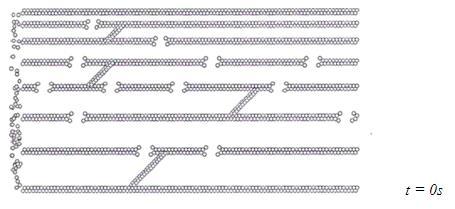
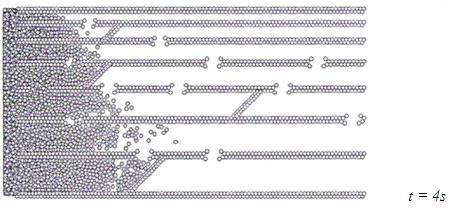
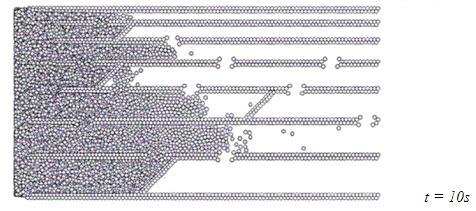
Fig. 2 Liquid filling of a fragment of the physical structure of pine over time.
By analyzing the sequence of patterns, it could be verified that the fluid moved faster with increasing diameter of the tracheid dc, and the dependence was approximately as
follows νf = ν0+ β√dc, where νf – fluid speed; ν0 - fluid speed in the smallest tracheid; β coefficient of proportionality.
Analysis of the concentration profiles of the liquid along the direction of impregnation (Figure 3) showed that, even though the piece of wood was gradually filled with fluid, the mass concentration of the liquid decreased in the direction of impregnation according to an approximately linear law.
When fluid moved, there were several characteristic pressures near the front of the fluid (Figure 4). The first characteristic pressure P1 (the smallest one) caused the fluid to move freely along the tracheid. The second characteristic pressure P2 caused fluid to flow through the pores.
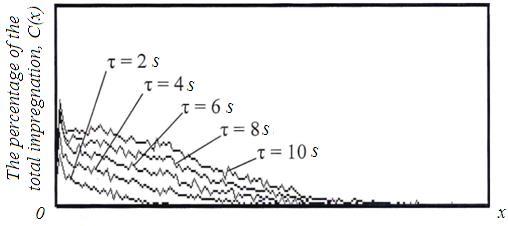
Fig. 3 Changes in the concentration of the impregnating fluid along the model fragment of pine over time.
Fig. 4 The change in pressure of the impregnating fluid along the model fragment of pine over time.
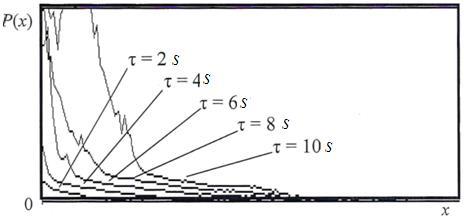
Hardwood species have different microscopic structure, so wood impregnation occurs differently. Figure 5 shows the sequence of wood impregnation. The drawings were made at the following time from the beginning of impregnation: 0, 2an d 8 s.
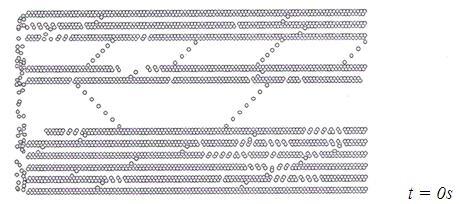
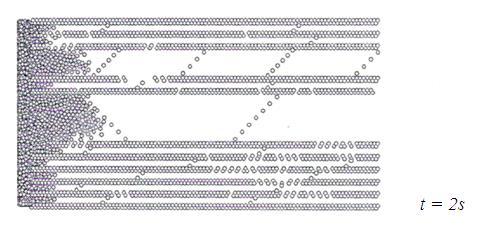
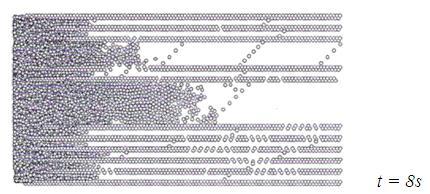
Fig. 5 Liquid filling of a fragment of birch structure over time.
The change in the percentage of the total impregnation fluid over time is presented in Figure 6. The change in pressure over time is represented in Figure 7.
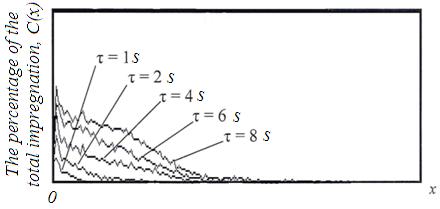
Fig. 6 The change in percentage of the total impregnation liquid along the model fragment of birch over time.
Fig. 7 The change in pressure of the impregnating liquid along the model fragment of birch over time.
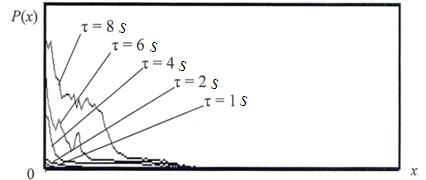
Comparing the results of computer experiment with the results of actual impregnation of pressed birch wood along the fibers on specimens of 50×50×100 mm (the last dimension is along the fibers) at initial impregnation stage (the duration is 8 s) showed their close convergence (Figure 8). The maximum discrepancy during the initial and final impregnation stages does not exceed 7%.
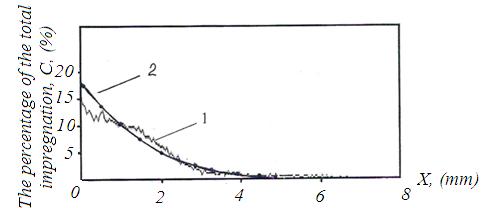
Fig. 8 The change in pressure over time is represented after 8 s from beginning of impregnation at a pressure of 0,8 MPa according to the results of computer (1) and active (2) experiment.
It is necessary to choose analytical formulas that describe the dependencies obtained as a result of experimental studies and computer experiments for an analytical description of the impregnation process.
The considered concentration profiles ω (x) and pressure P (x) are “step-like” (“sigmoidal”) curves: transitions of the function from a higher level to a lower one took place. Such a transition is well described by the Boltzmann sigmoidal function, which is often used in the description of chemical processes (Figure 9):
F(x)=F2+ (F1–F2) 1+��
��−��0 ��∙�� (3)
where F1andF2 – initial and final function values; d – multiplication factor; хо – inflection point of sigmoidal Boltzmann function.
Modifying the Boltzmann function as applied to the wood impregnation problem, we obtained the following impregnation equation: ��(��,��)=���� −
����−���� 1+exp(
��−��∙��01∙��
−��1�� ��∙������ ) (4)
where х–coordinate along the direction of impregnation; τ–impregnation time; ωI and ωC–the initial concentration of fluid in the wood and the concentration corresponding to the full impregnation; ν01–initial speed of the front of impregnation; k1–coefficient of impregnation front speed reduction; а and b–coefficients determining the expansion of the front of impregnation over time.
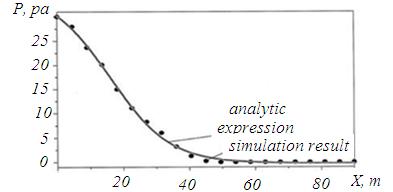
Fig. 9 Comparison of theoretical curve with the results of computer experiment.
The method of least squares was used to determine the coefficients of the proposed dependencies, according to the results of a theoretical study. The one-criterion optimization problem was solved in the six-dimensional parametric space R6 without any restrictions on variables. The objective function in this formulation of the optimization problem was unimodal in the whole definition domain: it had a single minimum that is global one. Minimum search was performed by iterative numerical method using Microcal Origin 5.0 program. There were constants that were included in the approximating expression within the framework of the method, according to the condition of the minimum of the sum of
squares of graph deviations from the points obtained in computer experiments. That is, the next optimization problem was solved: ��(��1,��2,…)=∑�� ��= (1 ��(��1,��2,…,����)−����(����))2 →min⟹��1,��2,… (5) wherea1, a2,… – constants (parameters) included in the approximating expression; N–number of computer experiment points; xi, yi–set of computer experiment points; i–computer experiment number; f (a1,a2,….,x.) –approximating function. Function limitations. The one-criterion optimization problem was solved in the six-dimensional parametric space R6 without restrictions on variables (the unconditional optimization problem). The objective function in this formulation of the optimization problem is unimodal in the whole definition domain: it has a single minimum that is global one. Minimum search was performed by iterative numerical method using Microcal Origin 5.0 program.
The solution of the optimization problem in the case of complex approximating expressions was made by an iterative method. In the framework of this work, the search for approximating expressions was performed using Microcal Origin 5.0 program, which is widely used in processing the results of the experiment.
As a result of approximation, the following equation of impregnation was obtained:
��(��,��)=0+
100
1+exp(��−��∙40∙�� −0 2+0,5�� ,2�� ) (6)
wherew is measured in percent of total impregnation; х–in millimeters; τ–in hours.
Figure 10 shows a series of concentration profiles calculated by the last equation. During the first hours of impregnation (1-2 hours), the front of the fluid moves quickly, however, starting from τ = 3 hours, the front movement slowed down, and the front of the impregnating liquid practically stopped in the wood approximately by τ = 5 hours, death of penetration was approximately 70 mm.
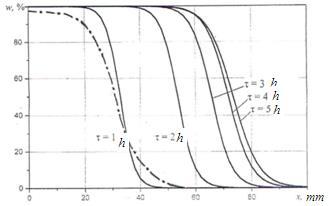
Fig. 10 Concentration profiles w (x) at different time values τ and experimental curve (--●--●--), obtained in 1 hour of natural birch wood treatment.
CONCLUSIONS
1. A physical model of the interaction of wood – liquid system in the form of balls (volumetric) and circles (flat) of the corresponding diameter, differing in the static position of the circles - wood elements and the dynamic state of the circles - liquid elements was developed. 2. It was developed by means of a computer experiment program and a system of differential equations was created and solved enabling to create a mathematical model of softwood (pine) and hardwood (birch) species treatment at micro level. 3. A physical model of meso-level wood treatment was developed taking into account temperature and pressure variables, differing in consideration of cavities, annual layers and core beams. On the basis of a mathematical model, analytical expressions were obtained for description of wood impregnation process. 4. With an increase in vessel diameter dV, the fluid speed νf increased approximately according to the following law: ���� =��0 +��√����, where ν0 - fluid speed in the smallest vessel; β - coefficient of proportionality. 5. Comparison of computer modeling results with the results of an active experiment showed their high resemblance.
REFERENCES
GUBANOVA, N. 2013. Modeling the process of wood impregnation with liquid. In Bulletin of Moscow State Forest University - Forest Bulletin. 2013. №3(95). p. 134138. LEKOUNOUGOU, S., KOCAEFE, D., OUMAROU, N., KOCAEFE, Y., PONCSAK, S. 2011. Effect of thermal modification on mechanical properties of canadian white birch (betulapapyrifera). In International Wood Products Journal. 2011. Vol. 2. p. 101107. ROWELL, R., ANDERSONE, I., ANDERSONS, B. 2012. Heat treatment. Chapter 14 in Handbook of Wood Chemistry and Wood Composites. Second Edition, CRC Press, 2012, p. 511536. SAMAEV, V, MEDVEDEV, I., PARINOV, D. 2018. Study of Modified wood As A Bearing material for Machine-Building International conference on Aviamechanical Engineering and Transport (Avia ENT2018), In Advances in Engineerin Research, 2018, vol. 158, p. 478482. SANDBERG, D., HALLER, P., NAVI, P. 2013. Thermo-hydro and thermo-hydro-mechanical wood processing: an opportunity for future environmentally friendly wood products. In Wood Material Science and Engineering. 2013, vol. 8, p. 6488. SHAMAEV, V, PARINOV, D. 2018. Patent 2646612 Russian Federation IPC B27K 3/02 (2006.01) Wood impregnation method; Applicant and patent holder Federal State Budgetary Educational Institution of Higher Education Voronezh State University of Forestry and Technologies named after G. F. Morozov. 2018, 6 P.
SHAMAEV, V., MANAEV, V., KONDRATYUK, V., VOSKOBOYNIKOV, I., SCHELOKOV, V., KONSTANTINOVA,S.,VARNAKOV,A. 2014. Patent №2511302 Russian Federation IPC A device for impregnating wood from an end face under pressure. 2014, 6 P. SHAMAEV, V., MEDVEDEV, I., PARINOV, D, SHAKIROVA, O., ANISIMOV, M. 2018. Investigation of physical and mechanical properties and microstructure of modified wood produced by self–pressing metod. In Acta Fakultatis Xylologiae Zvolen, 2018, 60(2): 2532. SHAMAEV, V., PARINOV, D., MEDVEDEV, I. 2018. Wood Modification by Pressing. In Engineering Studies. 2018, vol. 10, issue 3 (2), p. 708717. TSHABALALA, M., MCSWEENY, J., ROWELL R. 2012. Рeat treatment of wet wood fiber: a study of the effect of reaction conditions on the formation of furfurals. In Wood Material Science and Engineering. 2012, vol. 7, p. 202208. WEBSITE OF ACCOYA [electronic resource]. 2014. Access mode: https://www.accoya.com/whyaccoya/benefits/ - title from the screen.
WEBSITE OF KEBONY COMPANY [electronic resource]. 2018. Mode of access: http://kebony.com/en/products/ – title from screen. WESTIN, M. 2010. Durability of Modified Wood – Laboratory vs Field Performance. Technical Research Institute of Sweden, Boras, Sweden, 2010, 142 P. ZANKEVICH, O. 1974. The finite element method in the theory of structures and in continuum mechanics kevich, 1974, 283 P.
ADDRESSES OF AUTHORS
Vladimir Shamaev, doctor of engineering, professor of the Department of Wood Science Voronezh State University of Forestry and Technologies named after G.F. Morozov Voronezh Voronezh region Russian Federation drevstal@mail.ru Phone: +79802454092, +7(473)253-67-22. Home address: 96, Kholzunova str, apt. 105, Voronezh Voronezh region Russian Federation
40










